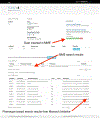matchbox: An open-source tool for patient matching via the Matchmaker Exchange
- PMID: 30240502
- PMCID: PMC6250066
- DOI: 10.1002/humu.23655
matchbox: An open-source tool for patient matching via the Matchmaker Exchange
Abstract
Rare disease investigators constantly face challenges in identifying additional cases to build evidence for gene-disease causality. The Matchmaker Exchange (MME) addresses this limitation by providing a mechanism for matching patients across genomic centers via a federated network. The MME has revolutionized searching for additional cases by making it possible to query across institutional boundaries, so that what was once a laborious and manual process of contacting researchers is now automated and computable. However, while the MME network is beginning to scale, the growth of additional nodes is limited by the lack of easy-to-use solutions that can be implemented by any rare disease database owner, even one without significant software engineering resources. Here, we describe matchbox, which is an open-source, platform-independent, portable bridge between any given rare disease genomic center and the MME network, which has already led to novel gene discoveries. We also describe how matchbox greatly reduces the barrier to participation by overcoming challenges for new databases to join the MME.
Keywords: Matchmaker Exchange; matchbox; novel gene; open-source; rare disease.
© 2018 Wiley Periodicals, Inc.
Figures
References
-
- Bone WP, Washington NL, Buske OJ, Adams DR, Davis J, Draper D, … Smedley D (2016). Computational evaluation of exome sequence data using human and model organism phenotypes improves diagnostic efficiency. Genetics in Medicine : Official Journal of the American College of Medical Genetics, 18(6), 608–617. 10.1038/gim.2015.137 [doi] - DOI - PMC - PubMed
-
- Buske OJ, Schiettecatte F, Hutton B, Dumitriu S, Misyura A, Huang L, … Brudno M (2015). The matchmaker exchange API: Automating patient matching through the exchange of structured phenotypic and genotypic profiles. Human Mutation, 36(10), 922–927. 10.1002/humu.22850 [doi] - DOI - PMC - PubMed
-
- Firth HV, Richards SM, Bevan AP, Clayton S, Corpas M, Rajan D, … Carter NP (2009). DECIPHER: Database of chromosomal imbalance and phenotype in humans using ensembl resources. American Journal of Human Genetics, 84(4), 524–533. 10.1016/j.ajhg.2009.03.010 [doi] - DOI - PMC - PubMed
-
- Girdea M, Dumitriu S, Fiume M, Bowdin S, Boycott KM, Chenier S, … Brudno M (2013). PhenoTips: Patient phenotyping software for clinical and research use. Human Mutation, 34(8), 1057–1065. 10.1002/humu.22347 [doi] - DOI - PubMed
-
- Guissart C, Latypova X, Rollier P, Khan TN, Stamberger H, McWalter K, … Küry S (2018). Dual molecular effects of dominant RORA mutations cause two variants of syndromic intellectual disability with either autism or cerebellar ataxia. The American Journal of Human Genetics, 0(0)10.1016/j.ajhg.2018.02.021 Retrieved from http://www.cell.com/ajhg/abstract/S0002-9297(18)30089-2 - DOI - PMC - PubMed
Publication types
MeSH terms
Grants and funding
LinkOut - more resources
Full Text Sources
Other Literature Sources
Medical
Molecular Biology Databases
Miscellaneous




